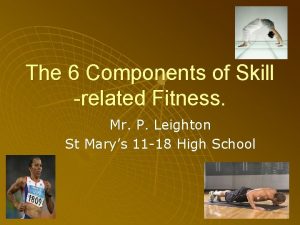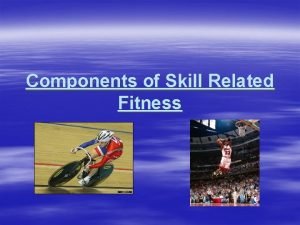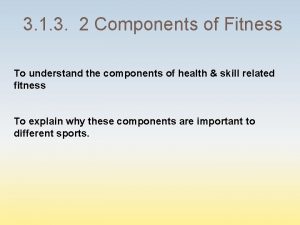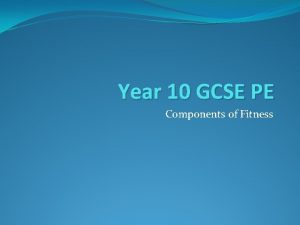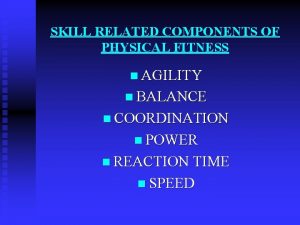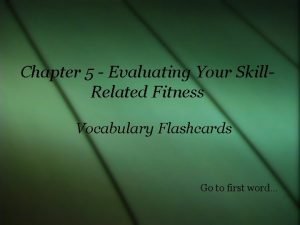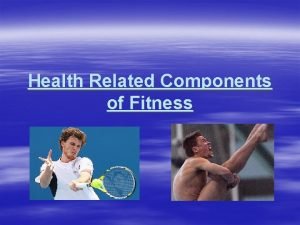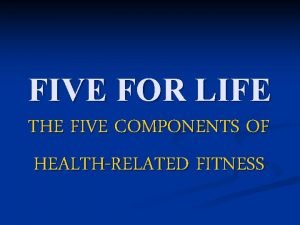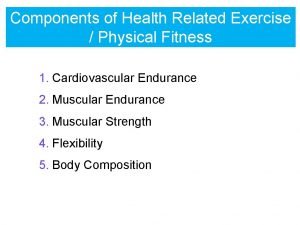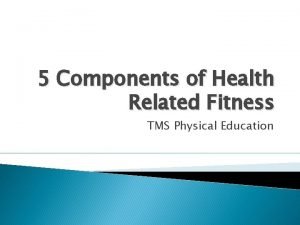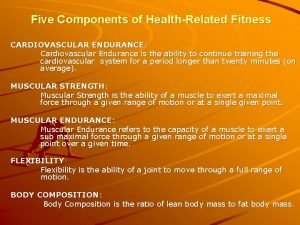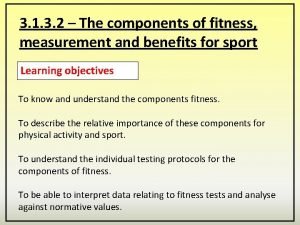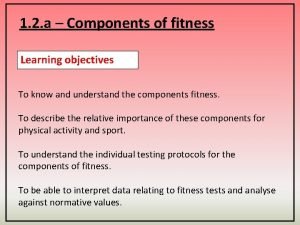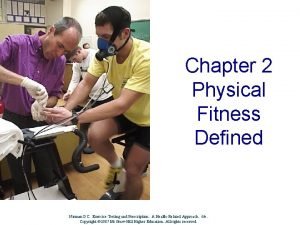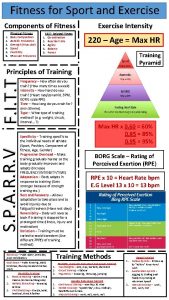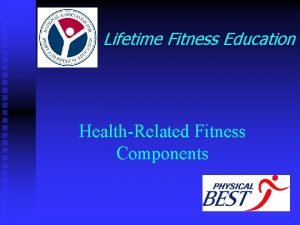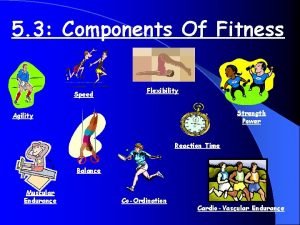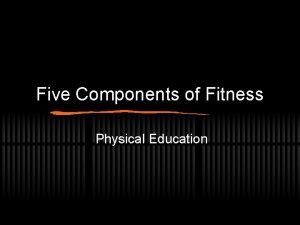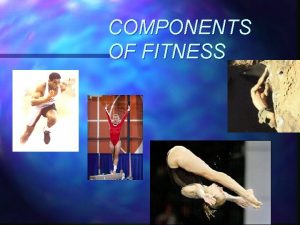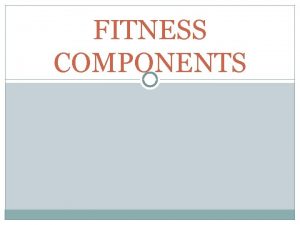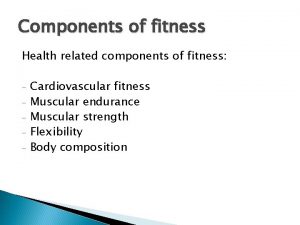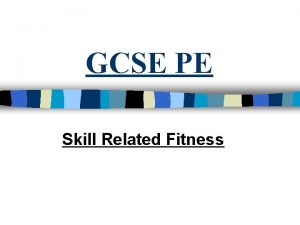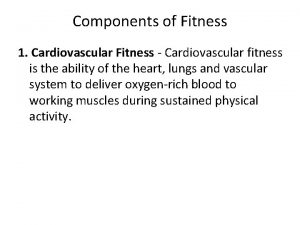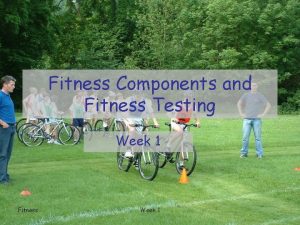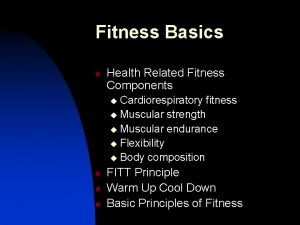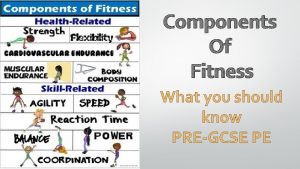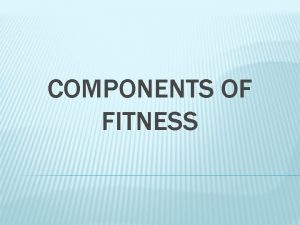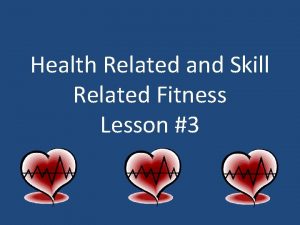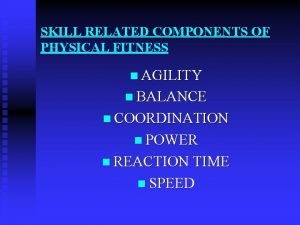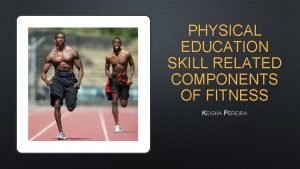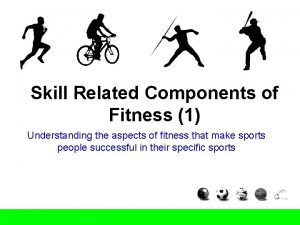PE SKILL RELATED COMPONENTS OF FITNESS SKILL VS




























- Slides: 28

PE

SKILL RELATED COMPONENTS OF FITNESS

SKILL VS. HEALTH REALTED COMPONENTS OF FITNESS n HEALTH- n SKILL- RELATED COMPONENTS n n skills that enable one to become and stay physically healthy. associated with disease prevention and functional health. RELATED COMPONENTS n n skills that will enhance one’s performance also called performance fitness.

AGILITY Øthe ability to change and control the direction and position of the body while maintaining a constant, rapid motion.

BALANCE Øthe ability to control or stabilize the body when standing still or moving.

COORDINATION Øability to use the senses together with body parts during movement.

POWER Øthe ability to perform with strength at a rapid pace.

REACTION TIME Øthe amount of time it takes to start a movement once your senses signal the need to move

SPEED Øthe ability to cover a distance in a short amount of time.

TRAINING PRINCIPLES § Getting the most out of n. Specificity your training requires a little planning. The best n. Progressio training programs are n built on basic fitness n. Overload principles. § To remember basic n. Regularity fitness principles, remember the acronym n. Reversibilit SPORRT y

SPECIFICITY n. To develop a particular fitness or skill component, you must perform exercises designed specifically for that component

PROGRESSION nstart slowly and gradually, over time, increase the amount of exercise and keep overloading.

OVERLOAD n the work load of exercise needs to exceeds the normal demands placed on the body to improve fitness.

OVERLOAD -FITT n FITT principle for overload: n. Frequency—How often n. Intensity—How hard n. Time—How long (duration) n. Type—Mode of activity

REGULARITY nmaintain an exercise regimen that is consistent, with exercise taking place at regular intervals.

REVERSIBILITY n. Fitness improvements are lost when demands on the body are lowered n If you stop exercising, up to 50% of fitness improvements are lost within 2 months

TEDIUM (Variety) n. Using a variety of training methods (or exercises) relieves tedium and avoids boredom in training and can also increase

TRAINING METHODS n. Individual fitness goals require different training methods. Each has its own advantages and disadvantages, some are better for advanced training and others more

Continuous Training nworking for a sustained period of time without rest. n improves cardiovascular fitness and muscular endurance

Interval Training n alternating between periods of hard exercise and rest. n improves speed, recovery time, muscular endurance, anaerobic

Fartlek Training n 'speed play' training involves varying speed and the type of terrain over which you run, walk, cycle, ski… n improves aerobic and

Circuit Training nperforming a series of exercises in a special order called a circuit. Each activity takes place at a 'station'. ngood for general fitness and can be structured to

Cross Training ncombines a variety of different exercises into one complete full-body workout.

Weight Training n uses weights to provide resistance to the muscles. n improves muscular strength (high weight, low reps), muscular endurance (low weight, high reps, many sets) and power (medium weight and reps performed quickly).

SAQ Training n Speed, Agility, Quickness n drills focusing on running mechanics, movement efficiency, coordination and reaction training. n improves speed, change of direction, reaction time and

Plyometrics n known as "jump training" or "plyos“ nexercises in which muscles exert maximum force in short intervals of time, with the goal of increasing power (speed-

Flexibility Training n exercises to possibly reduce your risk of injury, improve your flexibility and range of motion, and serve as a solid warm-up for more vigorous exercise. n yoga can strengthen and relax your muscles, while tai chi can reduce stress and improve your

BENEFITS OF EXERCISE: LOWER S C H STRENGTHENS HEART AND LUNGS OLESTEROS LSLEEP IMPROVE E C N E E ENHANCES FEELING OF WELL-BEING D I R F U ON C S S E S V STRENGTHENS MUSCLES O E R P R IMIMPROVES P D AND BONES O APPEARANCE BLO PREVENTS INJURY INCR S N E EAS A S E ES E S HELP EA A E N IS ERG SR D W N C T E COM Y EAR O DE POS IGHT CDOINATI FH ITION OR NTR N O O I K O T S O I L ASNR O C M S D F BOD O CE VE U E O Y D G RAN E S PR R E M I T REDUCES STRESS AND TENSIONIABE S E V D RO P M I
 Fitness related images
Fitness related images 6 components of fitness
6 components of fitness Balance skill-related fitness
Balance skill-related fitness 2 types of physical fitness
2 types of physical fitness Shot putter skill related fitness
Shot putter skill related fitness Gcse pe components of fitness
Gcse pe components of fitness What is agility in physical education
What is agility in physical education Chapter 5 skill related fitness crossword
Chapter 5 skill related fitness crossword Components of health related fitness
Components of health related fitness Five components of health related fitness
Five components of health related fitness Components of health related fitness
Components of health related fitness 5 components of health related fitness
5 components of health related fitness What are the components of fitness?
What are the components of fitness? Where is the ending point for hexagon agility test
Where is the ending point for hexagon agility test Ruler drop test normative data
Ruler drop test normative data Ruler drop test component of fitness
Ruler drop test component of fitness Health related fitness
Health related fitness Physical education 7
Physical education 7 Health related physical fitness definition
Health related physical fitness definition Fitness skill
Fitness skill What is soft skills
What is soft skills Components of fitness
Components of fitness Components of fitness btec sport
Components of fitness btec sport The ability to maintain the body in proper equilibrium
The ability to maintain the body in proper equilibrium Speed and agility frequency, intensity, time type
Speed and agility frequency, intensity, time type Speed flexibility
Speed flexibility Five components of fitness
Five components of fitness Physical education quiz
Physical education quiz 5 components of fitness worksheet
5 components of fitness worksheet

